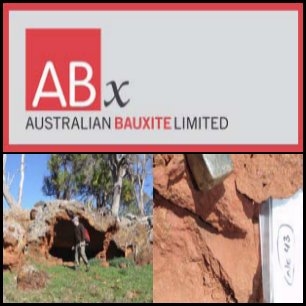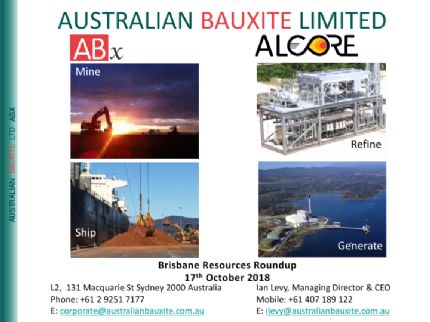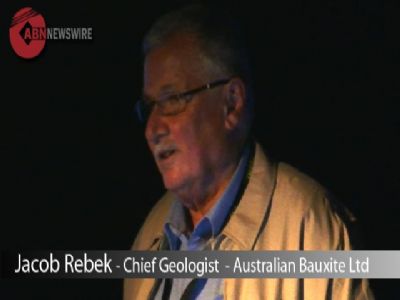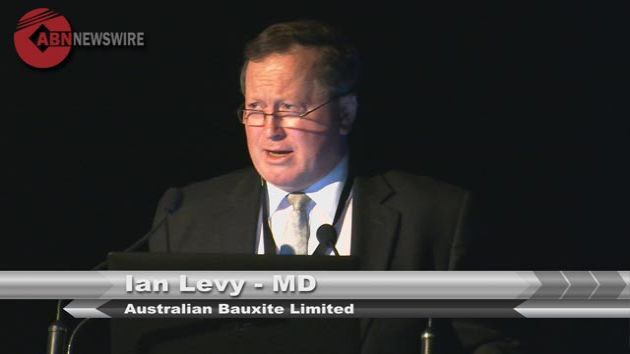
Australian Bauxite Limited (ASX:ABZ) Completes Transfer Of Queensland Tenements
Sydney, Jan 13, 2010 AEST (ABN Newswire) - Australian Bauxite Limited ( ASX:ABZ) has received advice from Queensland Mines and Energy that title in all the Queensland ABx Project Tenements have been transferred from Hudson Resources Limited to ABx3 Pty Ltd, a wholly owned subsidiary of ABx.
ASX:ABZ) has received advice from Queensland Mines and Energy that title in all the Queensland ABx Project Tenements have been transferred from Hudson Resources Limited to ABx3 Pty Ltd, a wholly owned subsidiary of ABx.
The effective date of transfer is 23rd December 2009.
Summaries of bauxite mineralisation in this release have been determined by hand-sampling in most instances, with limited systematic surface sampling recorded in some areas as noted.
EPM 17831 (Hillgrove) and EPM 17830 (Haden)
Introduction
The Hillgrove EPM, of 267 sq km and the Haden EPM, of 264 sq km cover prospective bauxite development over basalts subjected to extensive weathering and laterisation during the Tertiary (a period spanning a time frame from 2-65 million years ago). Sampling from sites on public roads has shown that bauxite is present and that there are areas for priority follow-up where low total silica and high to moderate total alumina assays are located. Two field trips have been completed that indicate the area to be a of medium priority for ground follow-up work and subsequent drill testing as the question of tonnage potential currently remains open due to younger Tertiary basalt overlying the bauxite.
Location
The tenements are only 40 km north from Toowoomba which offers a full range of services. A transport route by trucking 60 km to Kingaroy and then by rail to main Brisbane - Gladstone railway is an alternative. The coal mines at Ackland are 25 km away; an alumina plant could be considered in the vicinity in the longer term.
A further option would be selling beneficiated bauxite product with low reactive silica and high tri-hydrate [gibbsite] content to the existing alumina plants in Gladstone for blending with bauxite from Weipa.
Bauxite Mineralisation
Significant portions of the tenements are covered by Tertiary Volcanics. Geological and Digital Terrain Model / Landsat images led to conclusion that prospective bauxite areas extend into the Haden and Hillgrove EPMs however there appears to be significant younger Tertiary cover.
All samples taken were from sites on public roads. Apart from one bauxite occurrence at Pinelands, in the northeast part of the Haden EPM, there are no bauxite occurrences reported in literature for either Haden or Hillgrove EPMs.
Field work located bauxite outcrops and boulders in several areas:
- The area northwest of Haden returned low total silica and high to moderate total alumina assays.
- The area south of Haden gave low to moderate total silica and mostly moderate total alumina assays.
- The area north-east of Haden [including the area called 'Pinelands - northwest part] gave low to moderate total silica and mostly moderate total alumina assays and several samples gave low total silica and high to moderate total alumina assays so that this area is higher priority for follow-up.
Exploration Programme
Geological mapping of younger Tertiary Volcanic cover is required to determine the thickness of cover overlying the bauxite in this area. While this is a medium priority target area for ground follow-up work and subsequent drill testing, the question of tonnage potential remains open due to younger Tertiary basalt cover.
EPM 17790 (Hampton)
Introduction
The tenement, of 336 sq km, is 25 km north of Toowoomba and covers ground similar to that found in the Haden / Hampton area which is prospective for the development of bauxite on Tertiary Volcanics. Loose lumps of bauxite occur in the thick red soil in the upper part of the lateritic profile and at least 20 bauxite occurrences have previously been noted, including a number of outcrops of massive cemented bauxite layers. No systematic exploration has yet taken place.
This is a high priority area for drill testing because of good location, large tonnage potential and good quality. One option would be selling beneficiated bauxite product with low reactive silica content and high tri-hydrate [gibbsite] content to existing alumina plants in Gladstone for blending with bauxite from Weipa.
The assays are from samples of bauxite lumps after removal of friable red soil by screening as well as representative samples across the entire thickness of massive cemented bauxite outcrops. Preliminary grab samples suffer from soil contamination that can raise reactive silica levels and surface weathering that can reduce the Al2O3 content, but the results indicate low reactive silica assays and available alumina content within economic range. The yield of beneficiated product after wet screening is not known as no drilling has been undertaken but visual estimates of some exposures are that bauxite lumps represent 25 to 50% of total volume.
Location
The tenement is 25 km from Toowoomba close to existing infrastructure, rail, highway, power, water and coal mines with large reserves. Should sufficient resources of bauxite be proved up, it may be possible to consider a new alumina plant in the region.
The Toowoomba - Brisbane rail link is fully utilized so that transport by trucking 40 km to Gatton and then by railway would be the best option, or trucking 135 km to Brisbane port during the first phase of production.
Bauxite Mineralisation
Road-cuts and drains on side-roads, in red soil, reveal small to large lumps of bauxite with most known bauxite occurrences being located in southern part of the EPM where terrain is more dissected and road cuts are deeper. The best exploration potential is on the higher parts of the plateaus where the full lateritic profile could be preserved and may have substantial thickness of bauxite.
The EPM covers several red-soil plateaux underlain by weathered Tertiary volcanics [probably tuffs] with high feldspar content and no quartz. The plateaux cover an extensive area - the Pechey State Forest alone covers 16 sq km - and bauxite development from prolonged weathering in the Tertiary could be considerable as there are exposures with bauxite lumps well below the top of plateaux. The bauxite remained exposed to weathering.
The largest plateau is almost entirely covered by the Pechey State Forest and the plateau edge, with its partly preserved old lateritic weathering profile is well defined on the east side because of sharp drop-off due to rapid erosion by streams of Brisbane River catchment.
Field inspection and limited sampling indicates that in general terms the Pechey-Geham State Forest Targets have low iron enrichment and show:
- low total SiO2 [3 to 4%] and reactive SiO2 [2 to 3%]
- total Al2O3 [about 47%].
- high LOI in bauxite that has not been affected by surficial dehydration.
- available Al2O3 [about 38%] in large lumps that have not been affected by surficial dehydration.
- Fe2O3 [about 24%] possibly in discrete iron mineral grains that can be removed
by centrifuge or magnetic separation
- a large area, all in State Forest with a grid of existing forestry roads available for access.
Exploration Programme
The Pechey-Geham Plateau laterites will be drill tested. Drilling 200mm diameter auger holes through the "mechanical weathering zone" characterised by friable/dusty red soil with lumps of bauxite, should locate thick cemented layers of bauxite such as has been found at the Holder-Lockwood and Wimbledon Plateaux, where the typical thickness of cemented bauxite is about 6m.
The Pechey-Geham target areas, each with dimensions of around 10 to 16 sq km, could host between 40 million and 60 million cubic metres of raw unprocessed bauxite with from 28%-45% available Al2O3 and 1.5%-5% reactive silica and can be tested by about 20 holes drilled to a depth of 10m, to obtain data for analyses for alumina, silica, iron oxide and loss on ignition, followed by specialist analyses to determine total and available alumina, total and reactive quartz, loss on ignition and other analyses as required in bauxite search. Preliminary resource estimation will then be possible to determine the prospect of economic extraction and subsequent processing.
Various future options are available if sufficient bauxite is located. Subject to the expansion of the power industry in the Surat Basin, an alumina plant could be built in the vicinity. There is also the possible option of selling beneficiated bauxite product with low reactive silica content and high tri-hydrate [gibbsite] content to existing alumina plants in Gladstone for blending with bauxite from Weipa.
EPM 17800 (Red Hill) and EPM 17800 (Red Hill South)
Introduction
The EPMs, each of 300 sq km, cover a number of good exposures of bauxite and the underlying weathered older Tertiary volcanics [probably tuffs with high feldspar content and no quartz], from which the bauxite was derived. The geological setting and the position of the bauxite layer is similar to that in the Haden and Hillgrove EPMs with bauxite overlain by younger Tertiary volcanics which preserves the bauxite but may limit access. A series of new bauxite exposures have been located in a zone 2 km long, 1 km wide over which limited sampling suggests that this is a low priority area due to possible limitations from an unknown thickness of overlying younger Tertiary basalt cover.
Alumina values are consistently high and silica values are consistently low [32 to 46% Al2O3 and 3 to 5% SiO2], except for two samples. Iron values are consistently elevated [27 to 34% Fe2O3].
Location
The EPMs are well located 40 km south of Toowoomba. The transport route is by bitumen road 30 km to Gatton, which is on the main railway 80 km from the Brisbane port. Subject to the expansion of the power industry in the Surat Basin, an alumina plant could be built in the vicinity.
Bauxite Mineralisation
Significant portions of the EPMs are covered by Tertiary volcanics. These are underlain by sedimentary strata of Jurassic Walloon Coal Measures, which are part of extensive Jurassic sedimentary system of south east Queensland. Digital Terrain Model and Landsat images suggest that the volcanics have been deposited and are preserved on old peneplained surface.
The contact between Tertiary Volcanics and underlying sedimentary strata of Jurassic Walloon Coal Measures is close to horizontal therefore in every valley there may be exposures of Jurassic Walloon Coal Measures and on every rise / ridge, Tertiary volcanics may be preserved.
No systematic exploration for bauxite has been undertaken. There are known bauxite occurrences in the area. The West Haldon Bauxite and the Maryvale Bauxite and the geological setting appear to be analogous to that in Inverell area. The volcanics are probably tuffs with high feldspar content and no quartz. The bauxite is overlain by younger Tertiary volcanics. Recent field work located bauxite at West Halden, and also as outcrops in a broad zone 10 km long by 3 km wide. Assaying indicates low reactive silica but available alumina was mostly at lower limit for economic viability.
Based on observations from distance and interpretation of satellite images, an extensive target, 8 km by 6 km, with potential for extensions toward south, east, north and west has been identified.
Exploration Programme
Being similar to other tenements in the area, further work will include geological mapping of younger Tertiary Volcanic cover to determine the thickness of cover overlying the bauxite in this area. This is a medium priority target area for ground follow-up work and subsequent drill testing.
EPM 18014 (Binjour)
Introduction
Only a preliminary reconnaissance along public road exposures has been completed and two exposures of bauxite have been sampled. The Binjour application covers extensive plateaux with Tertiary volcanics and old weathered profiles preserved that are prime targets for bauxite. Bauxite occurrences have been noted in the Geological Survey data base and loose lumps of bauxite occur in the thick lateritic red soil profile developed on the volcanics.
This is a high priority area for drill testing because of good location and quality with the option of selling beneficiated bauxite product with low reactive silica and high tri-hydrate [gibbsite] content to existing alumina plants in Gladstone for blending with bauxite from Weipa.
The limited sample programme located some higher quality bauxite with reactive SiO2 at 3 to 6%; total Al2O3 at 48 to 50%; available Al2O3 at 40 to 41%; and LOI 17 to 23%.
Location
The EPM, of 150 sq km, is well positioned near the towns of Gayndah and Mundubbera and close to power, sealed highway and water. The distance to Gladstone by rail is 200 km. A railway is located on southern boundary of EPM, which is currently not in use however there is a plan to re-start mining of coal in Mulgildie Basin located 60 km to north-west and the railway may be used again.
Bauxite Mineralisation
Only one known bauxite occurrence has been noted in the area of the Binjour tenement, however significant portions of the EPM cover Tertiary volcanics that have been deposited as a thin package of near-horizontal strata resting on an old peneplained surface. The volcanics are preserved as a series of plateaux. A thick lateritic weathering profile is visible as red soil, and the potential for extensive bauxite development is indicated by road cuttings where lumps of bauxite are exposed.
Assays from initial samples show low reactive silica and high available alumina. Our 20 samples of bauxite were later collected from red soil at two new sites on two main plateaux [assays pending], and based on evidence from other tenements, drilling here should intersect a substantial thickness of bauxite.
There are several plateaux within the tenement representing remnants of old lateritic weathering surfaces and exploration will be directed to laterites developed over the volcanics.
The high parts of the plateaux are of greatest interest as the full lateritic profile may be preserved, and thickness in the order of 10m would result in a significant tonnage.
The southeastern Binjour Plateau has dimensions of 9 km by 2 km, which means a prospective area of more than 10 sq km. If half of the target area is underlain by an average thickness of 5m of cemented bauxite, there is a potential to host between 40 million and 60 million cubic metres of raw unprocessed bauxite containing 35%-50% total Al2O3." Current work on other bauxite tenements indicates that a 5m thick of bauxite layer is not uncommon.
However, until tested It is not possible to determine the prospect of economic extraction and subsequent processing.
Exploration Programme
Geological mapping and systematic sampling of outcrop and of the lateritic weathering profile exposures will be undertaken to obtain samples for analysis. After preliminary testing [excavator or drill rig], follow-up work will involve systematic grid drill testing to obtain data for analyses for alumina, silica, iron oxide and loss on Ignition, followed by specialist analyses to determine total and available alumina, total and reactive quartz, loss on ignition and other analyses as required in bauxite search. Preliminary resource estimation will then be possible.
For the complete Australian Bauxite ASX Announcement including Tables and Figures, please click the link below:
http://www.abnnewswire.net/media/en/docs/62060-ASX-ABZ-579438.pdf
About Australian Bauxite Ltd
 Australian Bauxite Limited (ABx) (ASX:ABX) has its first bauxite mine in Tasmania & controls the Eastern Australian Bauxite Province. ABx's 11 bauxite tenements in Queensland, New South Wales & Tasmania totalling 662 km2 are all 100% owned, unencumbered & free of third-party royalties. ABx's bauxite is gibbsite trihydrate (THA) bauxite that can be processed into alumina at low temperature.
Australian Bauxite Limited (ABx) (ASX:ABX) has its first bauxite mine in Tasmania & controls the Eastern Australian Bauxite Province. ABx's 11 bauxite tenements in Queensland, New South Wales & Tasmania totalling 662 km2 are all 100% owned, unencumbered & free of third-party royalties. ABx's bauxite is gibbsite trihydrate (THA) bauxite that can be processed into alumina at low temperature.
ABx has committed a large proportion of its expenditure into Research and Development to find ways to capitalise on the main strengths of its bauxite type which is very clean, free of all deleterious elements and partitioned into layers, nodules, particles and grains of different qualities that can be separated into different product streams using physical, chemical and geophysical methods.
ABx has declared large Mineral Resources in northern NSW, southern NSW, Binjour in central QLD & in northern Tasmania.
ABx's first mine commenced at Bald Hill near Campbell Town, Tasmania in December 2014 - the first new Australian bauxite mine for more than 35 years.
ABx aspires to identify large bauxite resources in the Eastern Australian Bauxite Province and has created significant bauxite development projects in 3 states, Queensland, New South Wales and Tasmania. Its bauxite deposits are favourably located for direct shipping of bauxite to both local and export customers.
ABx endorses best practices on agricultural land, strives to leave land and environment better than we find it. We only operate where welcomed.
| ||
|







